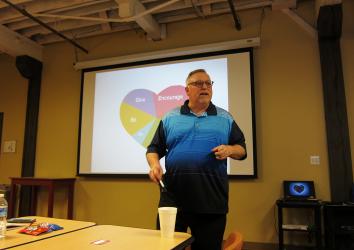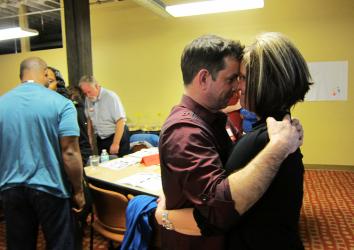“Oh My God—We’re on Welfare?!”
The strange story of what “welfare” has become since the 1996 reforms.

Digital Vision
This article is part of the series “Welfare Reform: 20 Years Later,” a collaboration between Slate and Marketplace. You can listen to Marketplace’s podcast on welfare, “The Uncertain Hour,” here.
“All right, so we’re gonna talk about love styles!”
On a Thursday night in Oklahoma City this winter, Scott Roby— white goatee, polo shirt, and slacks—stood at the front of a crowded conference room, next to an image of a big colorful heart projected on a PowerPoint screen. The heart was divided into six different sections representing different “love styles.”

“There’s Do, Be, Give, Encourage, Talk, and Touch. Those are the six different dimensions,” Roby, an instructor for a program called “Forever. For Real,” told his audience. “We all have all of these within us.”
As he talked, the 50 or so people in the room nudged their partners, exchanging knowing looks when their preferred love style came up. “Now, sensual touch—if it’s really gonna feed the love style and feed the relationship, it’s not always about ‘landing the plane,’ if you know what I mean,” Roby said with a wink.
Roby’s audience was mostly young or middle-aged professionals who’d come to his free, five-hour seminar straight from work, still in their business-casual. Everyone there was either married or engaged; “Forever. For Real” is open to any couple who lives in Oklahoma as a kind of marriage counseling 101 to help improve relationships and build strong marriages—and along the way, dance to a little Al Green, draw pictures of what modern marriage looks like (a bicycle? A microwave? A pizza?), and discuss ways of dividing household chores and resolving conflicts.

Krissy Clark
Over Chex Mix and pizza during a break in class, engaged couple Trey Martin, a prosthetist, and Lori Radford, a paralegal, were expressing relief at their discovery that they share the same love language (touch). They heard about this workshop at a bridal show—they’d get a $45 discount on their marriage license for attending.
Though I am newly married myself, relationship coaching was not why I was here at this session of “Forever. For Real.” I was here to ask couples such as Martin and Radford two questions.
Question No. 1: “How do you feel about welfare in this country?” I asked. “Do we spend enough? Too much? Not enough?”

Krissy Clark
“I think too much,” Radford quickly responded. “The people who receive it—a lot of those people don’t try to go find jobs. A lot of them just sit at home and they’re not looking to better themselves.”
Onto question No. 2: “What if I told you this class is funded by federal welfare dollars?”
Radford looked at her fiancé. They both wore a look of surprised amusement.
“Oh my god—we’re on welfare?!” Martin asked, chuckling. “I never thought I’d be on welfare.” Pause. “Well, that’s great!”
|
How Welfare Reform Failed
|
||
|
Your State on Welfare
|
||
|
Wait—I'm on Welfare?!
|
||
|
The Welfare Quiz
|
||
|
When You Can't Find Work or Welfare
|
||
|
Hillary Clinton's Role in Welfare Reform
|
Other couples were similarly bemused when I told them that welfare money, formally known as Temporary Assistance for Needy Families, or TANF, made their marriage class possible. Neoka Ashley, a recruiter for an employment agency, and her husband Paoli Wognakou, an IT analyst, certainly didn’t consider themselves needy. Ashley describes herself as “in need of like—maybe learning? But as far as benefits, we’re pretty good. Financially stable.”
Despite the stubborn stereotypes about just who benefits from federal welfare spending in America—how needy they are and whether they “just sit at home not looking to better themselves”— a workshop full of middle-class couples working on their love styles is exactly what welfare can look like today.
* * *
Twenty years after President Clinton worked with a Republican-led congress to transform the nation’s cash assistance program for poor families and “end welfare as we know it,” most Americans don’t know much about welfare at all.
“A tiny chunk of what we spend on welfare is spent on what people think of when they think of welfare,” says DeVon Douglass, policy analyst with the Oklahoma Policy Institute. And Oklahoma is just one of many states across the country where federal welfare dollars are going toward things that surprise even the people who are benefitting from them.
For example, in Michigan, welfare spending includes a program that gives private college scholarships to students from households with incomes as high as $250,000 or more. In Pennsylvania, welfare dollars go to funding for so-called “crisis pregnancy centers” that counsel women against abortions.
So, how did this crazy quilt of spending happen?
The reforms of 1996 focused on one program in particular, called Aid to Families with Dependent Children, or AFDC. For 60 years, AFDC had worked as an “entitlement” program: If a family fell below a certain poverty threshold, the family was entitled to cash assistance; the federal government spent as much money on the program each year as there were poor families who qualified. The welfare reform bill did away with AFDC and created in its place TANF, the new system for cash assistance. Under TANF, time limits and work requirements regulate if and for how long a family can receive cash assistance. And rather than the entitlement system of AFDC, funding for TANF comes in the form of block grants to states. The federal government sets aside a fixed amount of money each year—$16.5 billion, never adjusted for inflation since 1996—and gives every state a portion.
What states do with the money from there—that’s where things get weird.
“We say to states, ‘Here’s your chunk of it,’ ” explains Luke Shaefer, a professor at the University of Michigan School of Social Work who focuses on welfare policy. “And you can choose to use this money for cash assistance—a program that’s not particularly popular” and involves lots of paperwork and reporting requirements to run. “Or,” Shaefer says, “if you don’t use the money for cash assistance, you can use it for pretty much anything else. There’s virtually no oversight.”
Virtually no oversight, aside from four unassuming sentences tucked into the 1996 welfare reform bill under Title I, Section 103, labeled with the heading “Purpose,” outlining the basic ideas behind welfare and “welfare to work.” Purpose No. 1 is to “provide assistance to needy families” so children may be cared for in their own or a relatives’ home. Purpose two is to “end the dependence of needy parents on government benefits” by promoting job preparation, work —and marriage.
This is where the language takes a surprising turn toward the matrimonial. Purposes 3 and four 4 down on the marriage theme: to “prevent and reduce the incidence of out-of-wedlock pregnancies,” and, the flip side of that coin, “encourage the formation and maintenance of two-parent families.”
“That language did not appear mystically in the middle of the night,” says Ron Haskins of the Brookings Institution and an adviser to the White House and congressional Republicans during the welfare reform debate. Haskins tells me that the emphasis on marriage and family composition has a long history in the welfare reform movement among Republicans and Democrats alike who were alarmed by the rise of single-parent families, especially low-income families. As Haskins notes, census data from 2007–2009 shows that children in female-headed families are four to five times more likely to be in poverty than those in married families.
Yet the emphasis on marriage did not make a lot of headlines when the welfare reform bill was passed. President Clinton didn’t mention it when he signed the bill into law in the Rose Garden, declaring that the reforms were all about “moving people from welfare to work.”
Not even policy wonks like Liz Schott of the Center on Budget and Policy Priorities, or CBPP, took much notice of purposes 3 and 4 at the time. “I don’t think anyone really paid attention in 1996,” she says. “This happens to me when I read draft legislation—there’s all this ‘whereas’ stuff at the front, and this preamble language, and that’s just ‘blah, blah, blah.’ ”
But in the case of the welfare reform legislation, all the “whereas” stuff became much more than “blah blah blah.” Because the statute didn’t delineate clear rules on how states could spend their block grants, those four purposes took on greater significance, Schott says: “They control how the money can be spent.”
Schott and her colleagues have combed through the hundreds of annual reports states have sent to the feds since welfare reform, describing, often in frustratingly vague terms, where the money goes—all $16.5 billion of it—and which of the four purposes justifies that spending.
“When we started slicing and dicing and organizing them,” she says, “we began to see very dramatic patterns.” One of the most dramatic patterns Schott found was that nationwide, according to the latest data, states are collectively spending just a quarter of TANF money on actual cash assistance for poor families. Less than a quarter is being spent on child care and “work supports” to help those families find jobs. As for the rest of the money? Much of it is being spent on pretty much anything that might fit—even vaguely—under purposes 3 and 4.
“If TANF had been successful in getting all of these families from welfare to work, maybe it would be okay to start looking at other ways to be using these funds. But that’s not what happened,” Schott says. “What we’re seeing is poverty is increasing, while welfare receipt is decreasing.”
The small amount of money Oklahoma spends on cash assistance might make sense if no one in Oklahoma were poor anymore. But 17 percent of Oklahomans live below the poverty line (defined in 2016 as having an annual income less than $20,160 for a family of three). It’s just that very few of those families currently receive any cash welfare in Oklahoma—just 7 out of every 100 families who live in poverty. That number has dropped by more than 80 percent in the two decades since welfare reform kicked in. (Nationwide, the numbers aren’t much better: Fewer than 23 in 100 families living below the poverty line receive cash welfare.)
As for those marriage classes? Promoting marriage and preventing out-of-wedlock pregnancy in the state accounts for 5 percent, or nearly $10 million, of TANF spending in Oklahoma. By comparison, about $18 million, or 9 percent, of Oklahoma’s TANF budget, goes to cash assistance for poor families—what most Americans think of when they think of “welfare.”
“When I bring this up in conversation with my friends, there’s kind of a quizzical look on their face,” Douglass says about the amount of TANF spending directed toward cash assistance compared with the amount directed toward marriage promotion. “Is the government doing a matchmaking service? Does TANF help Tinder? How exactly does this work? People just don’t think that TANF is about getting people married.”
But for others in Oklahoma, it makes perfect sense. “At the most basic level, a two-income family is more likely to take people out of poverty than a one-income family,” says Mary Myrick, president of Public Strategies, the for-profit public relations firm that runs the Oklahoma Marriage Initiative and puts on relationship classes like “Forever. For Real.” Since 2001, her company has received more than $70 million from the TANF block grant to run relationship classes and produce advertisements in which middle class couples make dinner together and cuddle on the couch.
The idea for the Oklahoma Marriage Initiative took hold in in the late 1990s, after a state-commissioned report examined why it had one of the lowest per capita incomes in the country. The report, produced by economists at the University of Oklahoma and Oklahoma State University, pointed to the state’s divorce and out-of-wedlock birth rates—some of the highest in the country—as a cause. Taking advantage of the new flexibility built into how TANF block grants could be spent, Oklahoma’s then-Gov. Frank Keating decided to use some of the state’s TANF money to encourage marriage in the state.
Kendy Cox, who oversees many of Public Strategies’ relationship workshops, describes the thinking at the time as follows: “We spend in government so much time and so many resources dealing with the fallout of the family, perhaps we should do some things on the prevention side.”
Today, the Marriage Initiative includes more than a dozen different classes and workshops, including “Forever. For Real” for married and engaged couples; “Smart Singles” for singles; “Heart and Soul,” which is “focused on the African-American demographic”; and “Family Expectations” for expectant, often unmarried, parents. Some classes actively recruit in low-income populations. Most are open to everyone—rich, poor, and in between.
“We’re providing an opportunity for anybody in the state of Oklahoma to access services that can bolster not only their relationship, but their ability to stay self-sufficient and avoid poverty,” says Cox.
But the fact that all of the programs are funded by TANF dollars—the words “needy families” built right in to the acronym—has become a growing concern to some Oklahoma state officials. In the 15 years that the program has been going, the state’s poverty rate barely budged, and its marriage rate has continued to decline. And in late May, just before this story was published, the Oklahoma Department of Human Services, which oversees the allocation of TANF funding, announced that it plans to reduce the amount of welfare money that goes to the Marriage Initiative and relationship classes by more than $2 million, starting in July.
“Having healthy marriages is a worthy goal,” says Democratic state representative Jeannie McDaniel, who has been critical of the TANF funds that go to the Marriage Initiative. “I understand kids need two parents; I support marriage. But at the same time—is this the best use of TANF funds? That’s my bottom-line question.” McDaniel says she would rather see more TANF money directed toward job-training programs and other work supports like transportation vouchers. (Currently, Oklahoma spends less than 14 percent of its TANF money on these sorts of work supports.)
“On Maslow’s hierarchy of needs, it comes down to—you have to have shelter, you have to have food, and you have to have the skills you need to survive. I think we’d be better off concentrating our focus there,” McDaniel adds.
I asked Jim Struby, the director of adult and family services at the Oklahoma Department of Human Services, which oversees the cash welfare program, if it concerns him that so little money goes to basic assistance, while nearly as much goes to marriage and out-of-wedlock pregnancy prevention. “Yes, I’m keenly aware that low-income families are up against obstacles that upper- and middle-class families don’t have to deal with,” he says. “Any amount of support we can give them is important.”
But, he adds, “There are a lot of things to consider. One thing is, we pay for a lot of other important things with TANF dollars.”
Struby’s answer captures a paradox at the heart of how welfare spending is structured today—not just in Oklahoma but across the country. Every dollar the state doesn’t spend on basic cash assistance is a dollar it can spend on anything else it can justify under one of the four “purposes” of the welfare reform law—everything from marriage workshops to pre-K programs, all of which a state would otherwise have to pay for out of its own coffers. “Just the block grant structure alone has created incentives for states not to spend money on basic cash assistance,” Schott says.
“It’s kind of a shell game,” Shaefer says, arguing that there are “perverse incentives built into the very structure” of the block grant system. “You think of cash welfare as a program that primarily gets money into the pockets of poor families with kids. You think of it as a work program, supposed to support people get jobs.” But just half of TANF money goes toward those things, Shaefer says. “All this other money is going to other stuff.”
That “other stuff” includes everything from marriage initiatives and crisis pregnancy centers to foster care and services for the disabled. (Some states, including California, New York, and Nevada, do spend significant portions—more than 30 percent—of their TANF dollars on cash assistance. But those states are the exception, not the rule.) And regardless of how worthy those other programs may or may not be, Shaefer says, “It’s not at all what was intended by the program when it started.”
“You have this beautiful federal grant money that doesn’t have any strings attached to it—that’s basically what TANF is as a block grant,” says Douglass of the Oklahoma Policy Institute. “It’s the pretty money. And of course everybody wants 5 percent of that.” But, as 5 percent here and 5 percent there gets funneled to other programs, Douglass says, “we’re allowing people to live in poverty because of that. The devil’s in the details.”

